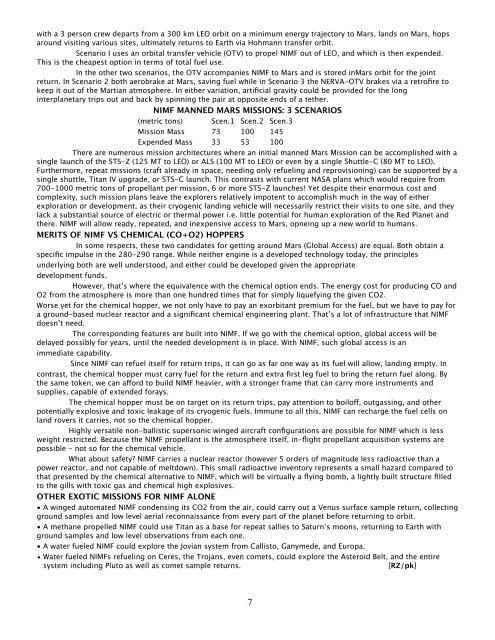Space Transportation - mmmt_transportation.pdf - Moon Society
Space Transportation - mmmt_transportation.pdf - Moon Society
Space Transportation - mmmt_transportation.pdf - Moon Society
You also want an ePaper? Increase the reach of your titles
YUMPU automatically turns print PDFs into web optimized ePapers that Google loves.
with a 3 person crew departs from a 300 km LEO orbit on a minimum energy trajectory to Mars, lands on Mars, hops<br />
around visiting various sites, ultimately returns to Earth via Hohmann transfer orbit.<br />
Scenario I uses an orbital transfer vehicle (OTV) to propel NIMF out of LEO, and which is then expended.<br />
This is the cheapest option in terms of total fuel use.<br />
In the other two scenarios, the OTV accompanies NIMF to Mars and is stored inMars orbit for the joint<br />
return. In Scenario 2 both aerobrake at Mars, saving fuel while in Scenario 3 the NERVA-OTV brakes via a retrofire to<br />
keep it out of the Martian atmosphere. In either variation, artificial gravity could be provided for the long<br />
interplanetary trips out and back by spinning the pair at opposite ends of a tether.<br />
NIMF MANNED MARS MISSIONS: 3 SCENARIOS<br />
(metric tons) Scen.1 Scen.2 Scen.3<br />
Mission Mass 73 100 145<br />
Expended Mass 33 53 100<br />
There are numerous mission architectures where an initial manned Mars Mission can be accomplished with a<br />
single launch of the STS-Z (125 MT to LEO) or ALS (100 MT to LEO) or even by a single Shuttle-C (80 MT to LEO).<br />
Furthermore, repeat missions (craft already in space, needing only refueling and reprovisioning) can be supported by a<br />
single shuttle, Titan IV upgrade, or STS-C launch. This contrasts with current NASA plans which would require from<br />
700-1000 metric tons of propellant per mission, 6 or more STS-Z launches! Yet despite their enormous cost and<br />
complexity, such mission plans leave the explorers relatively impotent to accomplish much in the way of either<br />
exploration or development, as their cryogenic landing vehicle will necessarily restrict their visits to one site, and they<br />
lack a substantial source of electric or thermal power i.e. little potential for human exploration of the Red Planet and<br />
there. NIMF will allow ready, repeated, and inexpensive access to Mars, opneing up a new world to humans.<br />
MERITS OF NIMF VS CHEMICAL (CO+O2) HOPPERS<br />
In some respects, these two candidates for getting around Mars (Global Access) are equal. Both obtain a<br />
specific impulse in the 280-290 range. While neither engine is a developed technology today, the principles<br />
underlying both are well understood, and either could be developed given the appropriate<br />
development funds.<br />
However, that’s where the equivalence with the chemical option ends. The energy cost for producing CO and<br />
O2 from the atmosphere is more than one hundred times that for simply liquefying the given CO2.<br />
Worse yet for the chemical hopper, we not only have to pay an exorbitant premium for the fuel, but we have to pay for<br />
a ground-based nuclear reactor and a significant chemical engineering plant. That’s a lot of infrastructure that NIMF<br />
doesn’t need.<br />
The corresponding features are built into NIMF. If we go with the chemical option, global access will be<br />
delayed possibly for years, until the needed development is in place. With NIMF, such global access is an<br />
immediate capability.<br />
Since NIMF can refuel itself for return trips, it can go as far one way as its fuel will allow, landing empty. In<br />
contrast, the chemical hopper must carry fuel for the return and extra first leg fuel to bring the return fuel along. By<br />
the same token, we can afford to build NIMF heavier, with a stronger frame that can carry more instruments and<br />
supplies, capable of extended forays.<br />
The chemical hopper must be on target on its return trips, pay attention to boiloff, outgassing, and other<br />
potentially explosive and toxic leakage of its cryogenic fuels. Immune to all this, NIMF can recharge the fuel cells on<br />
land rovers it carries, not so the chemical hopper.<br />
Highly versatile non-ballistic supersonic winged aircraft configurations are possible for NIMF which is less<br />
weight restricted. Because the NIMF propellant is the atmosphere itself, in-flight propellant acquisition systems are<br />
possible - not so for the chemical vehicle.<br />
What about safety? NIMF carries a nuclear reactor (however 5 orders of magnitude less radioactive than a<br />
power reactor, and not capable of meltdown). This small radioactive inventory represents a small hazard compared to<br />
that presented by the chemical alternative to NIMF, which will be virtually a flying bomb, a lightly built structure filled<br />
to the gills with toxic gas and chemical high explosives.<br />
OTHER EXOTIC MISSIONS FOR NIMF ALONE<br />
• A winged automated NIMF condensing its CO2 from the air, could carry out a Venus surface sample return, collecting<br />
ground samples and low level aerial reconnaissance from every part of the planet before returning to orbit.<br />
• A methane propelled NIMF could use Titan as a base for repeat sallies to Saturn’s moons, returning to Earth with<br />
ground samples and low level observations from each one.<br />
• A water fueled NIMF could explore the Jovian system from Callisto, Ganymede, and Europa.<br />
• Water fueled NIMFs refueling on Ceres, the Trojans, even comets, could explore the Asteroid Belt, and the entire<br />
system including Pluto as well as comet sample returns. [RZ/pk]<br />
7















